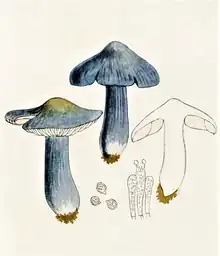Entoloma bloxamii
Entoloma bloxamii, commonly known as the midnight blue entoloma,[3] or big blue pinkgill,[4] is a species of agaric (gilled mushroom) in the family Entolomataceae. The species has a European distribution, occurring mainly in agriculturally unimproved grassland.[1] Entoloma bloxamii has been reported from North America, but at least some of these reports represent a distinct species, Entoloma medianox.[5] Threats to its habitat have resulted in the Big Blue Pinkgill being assessed as globally "vulnerable" on the IUCN Red List of Threatened Species.[1]
| Entoloma bloxamii | |
|---|---|
 | |
| Entoloma bloxamii illustrated by Giacomo Bresadola | |
| Scientific classification | |
| Domain: | Eukaryota |
| Kingdom: | Fungi |
| Division: | Basidiomycota |
| Class: | Agaricomycetes |
| Order: | Agaricales |
| Family: | Entolomataceae |
| Genus: | Entoloma |
| Species: | E. bloxamii |
| Binomial name | |
| Entoloma bloxamii | |
| Synonyms[2] | |
Taxonomy
The species was originally described from England in 1854 and named Agaricus Bloxami (sic) by Miles Joseph Berkeley and Christopher Edmund Broome, in honour of its collector, the naturalist and clergyman Andrew Bloxam. It was transferred to the genus Entoloma by the Italian mycologist Pier Andrea Saccardo in 1887.
Recent molecular research, based on cladistic analysis of DNA sequences, has shown that Entoloma bloxamii sensu lato comprises a number of distinct blue taxa in Europe,[6] including Entoloma bloxamii sensu stricto, Entoloma madidum (previously considered a synonym), E. atromadidum, E. ochreoprunuloides f. hyacinthinum, and an additional as yet unnamed species.[7] Collections from the west coast of North America, formerly referred to E. bloxamii or E. madidum, are also distinct[6] and are now referred to Entoloma medianox.[5]
Description
Basidiocarps are agaricoid, up to 45 mm (1.75 in) tall, the cap conical becoming convex to conical, up to 50 mm (2 in) across. The cap surface is smooth, pale greyish blue at first becoming greyish brown. The lamellae (gills) are white becoming pink from the spores. The stipe (stem) is smooth, finely fibrillose, white with greyish blue streaks, often yellowish at the base, lacking a ring. The spore print is pink, the spores (under a microscope) multi-angled, inamyloid, measuring about 7.5 to 9.5 by 7 to 9.5 μm.[6]
Similar species
Entoloma madidum is a deeper, slightly violet blue and retains some of its colour when old. Microscopically it has smaller spores (6 to 7.5 μm).[6] Entoloma atromadidum is similar but a darker, indigo blue and E. ochreoprunuloides f. hyacinthinum is dark brown with violaceous tints.[7]
Distribution and habitat
The Big Blue Pinkgill is rare but widespread in Europe.[1] Like many other European pinkgills, it occurs in old, agriculturally unimproved, short-sward grassland (pastures and lawns). It is usually associated with calcareous soils although it may also be found in more acidic areas.[8]
Conservation
Entoloma bloxamii is typical of waxcap grasslands, a declining habitat due to changing agricultural practices. As a result, the species is of global conservation concern and is listed as "vulnerable" on the IUCN Red List of Threatened Species.[1]
See also
| Entoloma bloxamii | |
|---|---|
| Gills on hymenium | |
| Cap is convex | |
| Hymenium is adnexed | |
| Stipe is bare | |
| Spore print is pink | |
| Edibility is not recommended | |
References
- Jordal J. (2019). "Entoloma bloxamii". IUCN Red List of Threatened Species. IUCN. 2019: e.T147245319A147869057. doi:10.2305/IUCN.UK.2019-2.RLTS.T147245319A147869057.en.
- "Entoloma bloxamii". Global Biodiversity Information Facility. Retrieved 16 May 2022.
- Thiers, Harry D.; Arora, David (September 1980). "Mushrooms Demystified". Mycologia. 72 (5): 1054. doi:10.2307/3759750. ISSN 0027-5514. JSTOR 3759750.
- Holden L. (July 2014). "English names for fungi 2014". British Mycological Society. Archived from the original on 23 September 2015. Retrieved 6 February 2016.
- Schwartz C (2015). "Entoloma medianox, a new name for a common species on the Pacific coast of North America" (PDF).
- Morgado LN, Noordeloos ME, Lamoureux Y, Geml J (2013). "Multi-gene phylogenetic analyses reveal species limits, phylogeographic patterns, and evolutionary histories of key morphological traits in Entoloma (Agaricales, Basidiomycota)". Persoonia. 31: 159–178. doi:10.3767/003158513X673521. PMC 3904048. PMID 24761041.
- Ainsworth AM, Douglas B, Suz LM (2018). "Big Blue Pinkgills formerly known as Entoloma bloxamii in Britain: E. bloxamii s. str., E. madidum, E. ochreoprunuloides forma hyacinthinum and E. atromadidum sp. nov". Field Mycology. 19 (1): 5–14. doi:10.1016/j.fldmyc.2018.01.004.
- Courtecuisse, R. & Duhem, B. (1995) Mushrooms and toadstools of Britain and Europe. Harper Collins, London.
